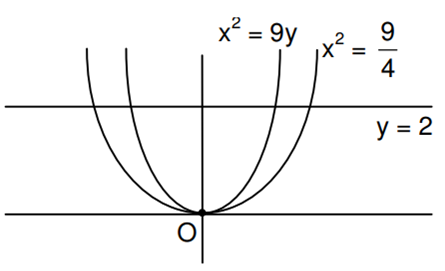 Multiple Choice Questions
Multiple Choice QuestionsThe area bounded between the parabolas x2=y/4 and x2 = 9y, and the straight line y = 2 is




C.



If z ≠ 1 and  is real, then the point represented by the complex number z lies
is real, then the point represented by the complex number z lies
either on the real axis or on a circle passing through the origin
on a circle with centre at the origin
either on the real axis or on a circle not passing through the origin
either on the real axis or on a circle not passing through the origin
The length of the diameter of the circle which touches the x-axis at the point (1, 0) and passes through the point (2, 3) is
10/3
3/5
6/5
6/5
An ellipse is drawn by taking a diameter of the circle (x–1)2 + y2 = 1 as its semiminor axis and a diameter of the circle x2 + (y – 2)2 = 4 as its semi-major axis. If the centre of the ellipse is the origin and its axes are the coordinate axes, then the equation of the ellipse is
4x2+ y2 = 4
x2 +4y2 =8
4x2 +y2 =8
4x2 +y2 =8
For a regular polygon, let r and R be the radii of the inscribed and the circumscribed circles. A false statement among the following is
there is a regular polygon with r/R = 1/2
there is a regular polygon with 
there is a regular polygon with r/R = 2/3
there is a regular polygon with r/R = 2/3
hyperbola passes through the point P(√2, √3) and has foci at (± 2, 0). Then the tangent to this hyperbola at P also passes through the point




The eccentricity of an ellipse whose centre is at the origin is 1/2. If one of its directives is x= –4, then the equation of the normal to it at (1,3/2) is
x + 2y = 4
2y – x = 2
4x – 2y = 1
4x – 2y = 1
The ellipse x2+ 4y2= 4 is inscribed in a rectangle aligned with the coordinate axes, which in turn is inscribed in another ellipse that passes through the point (4, 0). Then the equation of the ellipse is
x2+ 16y2= 16
x2+ 12y2= 16
4x2+ 48y2= 48
4x2+ 48y2= 48
A focus of an ellipse is at the origin. The directrix is the line x = 4 and the eccentricity is 1/2. Then the length of the semi−major axis is
8/3
2/3
5/3
5/3
A parabola has the origin as its focus and the line x = 2 as the directrix. Then the vertex of the parabola is at
(0, 2)
(1, 0)
(0,1)
(0,1)
